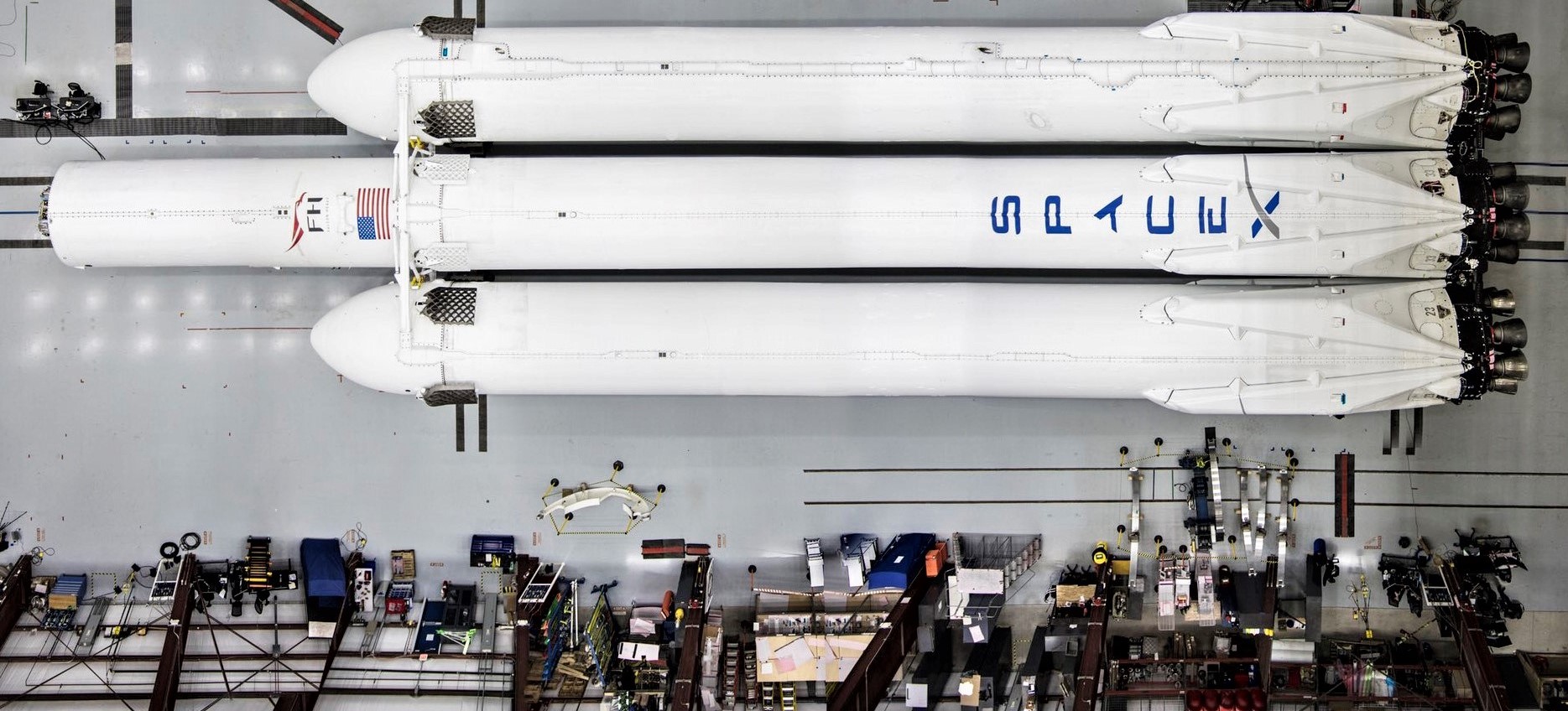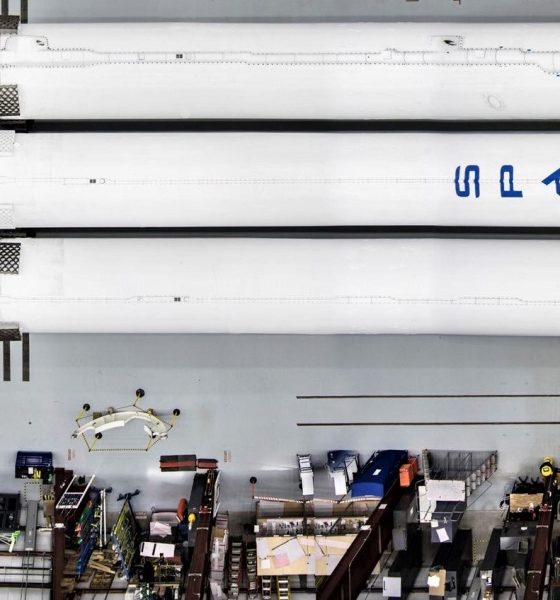

SpaceX
SpaceX’s April 7th Falcon Heavy launch a step toward new commercial markets
A bit less than 14 months after SpaceX’s Falcon Heavy took to the sky for the first time, the company’s super-heavy-lift rocket – the only such vehicle in the world that is currently operational – has garnered a pending date for its second launch attempt and commercial debut.
While there is some inherent uncertainty surrounding the (once again) fairly new rocket, SpaceX has now officially filed a plan with the Cape Canaveral range authorities that would see Falcon Heavy nominally conduct a critical static fire test as soon as March 31st, followed one week later by a launch target of no earlier than (NET) 6:36 pm EDT (22:36 UTC), April 7th. Set to place the ~6000 kg (13,200 lb) Arabsat 6A communications satellite in a high-energy geostationary orbit, a successful mission that ultimately proves Falcon Heavy’s commercial utility could also raise global launch market interest in the rocket, including potential anchor customers like NASA.
Falcon Heavy enters a different era
While it could be fairly argued that SpaceX has already near-flawlessly demonstrated Falcon Heavy’s performance and basic existence with the rocket’s February 2018 launch debut, that debut is really only half the story when it comes to breaking into commercial markets as a serious contender. Above all else, the fact remains that Falcon Heavy is often seen as infamous for what is perceived as a torturous, delay-ridden period of development, a common partial misunderstanding that has not exactly been combated by the now 14+ months separating the rocket’s first and second launch attempts. In the industries that have the most potential interest in Falcon Heavy, on-time launches are a central selling point of launch vehicles, with affordability effectively being a luxury behind timeliness and overall reliability.
Despite the success of Falcon Heavy’s debut, what SpaceX has not yet demonstrated is the ability to reliably and accurately insert a large customer payload into a specific orbit, for a specific (i.e. contracted) price. Adding another partial hurdle to the path before Falcon Heavy, the rocket’s first launch featured a hardware setup that could be described as a one-off, owing to the fact that Flight 1 utilized a mishmash of flight-proven Block 2 boosters and one unique Block 3-derived center core. By the time that the rocket was ready for its first launch, SpaceX was just three months away from debuting Falcon 9’s Block 5 variation, framed as the family’s ‘final’ version. Featuring an extensive range of major changes to Falcon structures, Merlin engines, avionics, reusability, and manufacturing processes, this ultimately meant that the next Falcon Heavy to fly would be a significantly different rocket compared to its sole predecessor.

While we actually know very little about what the task of re-certifying Falcon Heavy’s Block 5 upgrade for flight entailed, the minimum of 14 months separating flights 1 and 2 offers at least a partial idea of just how extensive the required rework was. With a long-delayed customer’s extremely expensive (likely $150-300M+) satellite on the line, there is a surplus of pressure on SpaceX to both complete this launch flawlessly and do so as soon as possible.
If all goes well with the imminent launch of Arabsat 6A and the USAF’s STP-2 mission shortly thereafter, SpaceX will have done a great deal to assuage many industry doubts about Falcon Heavy, particularly its practical launch availability and the company’s ability to ensure that its launches are at least roughly on-time. As of today, SpaceX has won five firm launch contracts for Falcon Heavy – three in the last year alone – and has the potential to acquire several additional contracts in the coming years, ranging from additional national security satellites from the NRO and USAF to flagship NASA science missions like the Jupiter-bound Europa Clipper. Aside from Blue Origin’s New Glenn (launch debut NET 2021), ULA’s Vulcan (also NET 2021), and ULA’s Delta IV Heavy (likely far too expensive), SpaceX’s Falcon Heavy is also the frontrunner for commercial contracts to launch segments of a proposed lunar space station, with launches potentially beginning as early as the early 2020s.
Further still, NASA administrator Jim Bridenstine announced earlier this month that the space agency was actively considering a stand-in fix for
Either way, the long term prospects of Falcon Heavy rocket could potentially be both lucrative for SpaceX and immensely beneficial for satellite industries and national space agencies alike. If SpaceX can demonstrate that it has inherited Falcon 9’s now thoroughly impressive reliability and moderate to great schedule assurance, the market for Falcon Heavy could end up supporting a major fraction of SpaceX’s sizable launch business.

Check out Teslarati’s Marketplace! We offer Tesla accessories, including for the Tesla Cybertruck and Tesla Model 3.

Elon Musk
Starlink passes 9 million active customers just weeks after hitting 8 million
The milestone highlights the accelerating growth of Starlink, which has now been adding over 20,000 new users per day.

SpaceX’s Starlink satellite internet service has continued its rapid global expansion, surpassing 9 million active customers just weeks after crossing the 8 million mark.
The milestone highlights the accelerating growth of Starlink, which has now been adding over 20,000 new users per day.
9 million customers
In a post on X, SpaceX stated that Starlink now serves over 9 million active users across 155 countries, territories, and markets. The company reached 8 million customers in early November, meaning it added roughly 1 million subscribers in under seven weeks, or about 21,275 new users on average per day.
“Starlink is connecting more than 9M active customers with high-speed internet across 155 countries, territories, and many other markets,” Starlink wrote in a post on its official X account. SpaceX President Gwynne Shotwell also celebrated the milestone on X. “A huge thank you to all of our customers and congrats to the Starlink team for such an incredible product,” she wrote.
That growth rate reflects both rising demand for broadband in underserved regions and Starlink’s expanding satellite constellation, which now includes more than 9,000 low-Earth-orbit satellites designed to deliver high-speed, low-latency internet worldwide.
Starlink’s momentum
Starlink’s momentum has been building up. SpaceX reported 4.6 million Starlink customers in December 2024, followed by 7 million by August 2025, and 8 million customers in November. Independent data also suggests Starlink usage is rising sharply, with Cloudflare reporting that global web traffic from Starlink users more than doubled in 2025, as noted in an Insider report.
Starlink’s momentum is increasingly tied to SpaceX’s broader financial outlook. Elon Musk has said the satellite network is “by far” the company’s largest revenue driver, and reports suggest SpaceX may be positioning itself for an initial public offering as soon as next year, with valuations estimated as high as $1.5 trillion. Musk has also suggested in the past that Starlink could have its own IPO in the future.
News
SpaceX shades airline for seeking contract with Amazon’s Starlink rival

SpaceX employees, including its CEO Elon Musk, shaded American Airlines on social media this past weekend due to the company’s reported talks with Amazon’s Starlink rival, Leo.
Starlink has been adopted by several airlines, including United Airlines, Qatar Airways, Hawaiian Airlines, WestJet, Air France, airBaltic, and others. It has gained notoriety as an extremely solid, dependable, and reliable option for airline travel, as traditional options frequently cause users to lose connection to the internet.
Many airlines have made the switch, while others continue to mull the options available to them. American Airlines is one of them.
A report from Bloomberg indicates the airline is thinking of going with a Starlink rival owned by Amazon, called Leo. It was previously referred to as Project Kuiper.
American CEO Robert Isom said (via Bloomberg):
“While there’s Starlink, there are other low-Earth-orbit satellite opportunities that we can look at. We’re making sure that American is going to have what our customers need.”
Isom also said American has been in touch with Amazon about installing Leo on its aircraft, but he would not reveal the status of any discussions with the company.
The report caught the attention of Michael Nicolls, the Vice President of Starlink Engineering at SpaceX, who said:
“Only fly on airlines with good connectivity… and only one source of good connectivity at the moment…”
CEO Elon Musk replied to Nicolls by stating that American Airlines risks losing “a lot of customers if their connectivity solution fails.”
American Airlines will lose a lot of customers if their connectivity solution fails
— Elon Musk (@elonmusk) December 14, 2025
There are over 8,000 Starlink satellites in orbit currently, offering internet coverage in over 150 countries and territories globally. SpaceX expands its array of satellites nearly every week with launches from California and Florida, aiming to offer internet access to everyone across the globe.
Currently, the company is focusing on expanding into new markets, such as Africa and Asia.
News
Tesla hints at Starlink integration with recent patent
“By employing polymer blends, some examples enable RF transmission from all the modules to satellites and other communication devices both inside and outside the vehicle.”

Tesla hinted at a potential Starlink internet terminal integration within its vehicles in a recent patent, which describes a vehicle roof assembly with integrated radio frequency (RF) transparency.
The patent, which is Pub. No U.S. 2025/0368267 describes a new vehicle roof that is made of RF-transparent polymer materials, allowing and “facilitating clear communication with external devices and satellites.”
Tesla believes that a new vehicle roof design, comprised of different materials than the standard metallic or glass elements used in cars today, would allow the company to integrate modern vehicular technologies, “particularly those requiring radio frequency transmission and reception.
Tesla has recently filed a US patent application on integrating RF transparent materials into the roof structure.
“facilitating clear communication with external devices and satellites”
Tesla fleet is getting @Starlink connectivity integration soon. LFG @Tesla @elonmusk… pic.twitter.com/bLa8YtPLd1
— Chansoo Byeon (@Chansoo) December 9, 2025
Instead of glass or metallic materials, Tesla says vehicles may benefit from high-strength polymer blends, such as Polycarbonate, Acrylonitrile Butadiene Styrene, or Acrylonitrile Styrene Acrylate.
These materials still provide ideal strength metrics for crashworthiness, stiffness for noise, vibration, and harshness control, and are compliant with head impact regulations.
They would also enable better performance with modern technologies, like internet terminals, which need an uninterrupted signal to satellites for maximum reception. Tesla writes in the patent:
“By employing polymer blends, some examples enable RF transmission from all the modules to satellites and other communication devices both inside and outside the vehicle.”

One of the challenges Tesla seems to be aware of with this type of roof design is the fact that it will still have to enable safety and keep that at the forefront of the design. As you can see in the illustration above, Tesla plans to use four layers to increase safety and rigidity, while also combating noise and vibration.
It notes in the patent that disclosed examples still meet the safety requirements outlined in the Federal Motor Vehicle Safety Standards (FMVSS).
Starlink integrated directly into Tesla vehicles would be a considerable advantage for owners. It would come with a handful of distinct advantages.
Initially, the inclusion of Starlink would completely eliminate cellular dead zones, something that is an issue, especially in rural areas. Starlink would provide connectivity in these remote regions and would ensure uninterrupted service during road trips and off-grid adventures.
It could also be a critical addition for Robotaxi, as it is crucial to have solid and reliable connectivity for remote monitoring and fleet management.
Starlink’s growing constellation, thanks to SpaceX’s routine and frequent launch schedule, will provide secure, stable, and reliable internet connectivity for Tesla vehicles.
Although many owners have already mounted Starlink Mini dishes under their glass roofs for a similar experience, it may be integrated directly into Teslas in the coming years, either as an upgrade or a standard feature.








